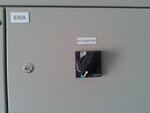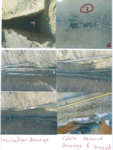tipu_sultan
Member level 1
Scenario:-
Distribution Substation. [SMDB-S AREA].
Electrical Room. [MDB-CAB-4]
3x(4C-300 mm2 XLPE/SWA Cu Conductor+ 1C-16 mm2 Y/G ECC )
There is a fault between cables which have been connecting form Substation to Electrical room having length of 300 meter approximately. There is a solid link between substation and electrical room having rating 630 A HRC Solid Links.
These cables have been laid by many years ago and did by other group. During excavation the one cable to be found with five straight joint, second with two, and third with insulation damage. (As mentioned in attached pictures).
The cables have been tested by performing MEGGER TEST @ 500 V (using MIT515) by disconnecting the terminals from both sides. (Refer attached photos).
My questions are as follows.
Which is the minimum resistance in which cable say to be okay or it depend upon the output load?
When performing the test the MEGGER MIT515 Device shows the output result in 1TΩ while on second time it yields the value of 0.97 GΩ. Why is there any reason?
All Cables with at least one core have given the fault. (My observation Less than 200 MΩ fault).




What is the best solution based on the situation. [Economical Solution].
Needs replace all cables?
Open/Cut cable from Straight Joint and perform again the MEGGER?
May be some device/ instrument which solve the solution (detect the cable fault at exact location)?
Other Solution?
Distribution Substation. [SMDB-S AREA].
Electrical Room. [MDB-CAB-4]
3x(4C-300 mm2 XLPE/SWA Cu Conductor+ 1C-16 mm2 Y/G ECC )
There is a fault between cables which have been connecting form Substation to Electrical room having length of 300 meter approximately. There is a solid link between substation and electrical room having rating 630 A HRC Solid Links.
These cables have been laid by many years ago and did by other group. During excavation the one cable to be found with five straight joint, second with two, and third with insulation damage. (As mentioned in attached pictures).
The cables have been tested by performing MEGGER TEST @ 500 V (using MIT515) by disconnecting the terminals from both sides. (Refer attached photos).
My questions are as follows.
Which is the minimum resistance in which cable say to be okay or it depend upon the output load?
When performing the test the MEGGER MIT515 Device shows the output result in 1TΩ while on second time it yields the value of 0.97 GΩ. Why is there any reason?
All Cables with at least one core have given the fault. (My observation Less than 200 MΩ fault).




What is the best solution based on the situation. [Economical Solution].
Needs replace all cables?
Open/Cut cable from Straight Joint and perform again the MEGGER?
May be some device/ instrument which solve the solution (detect the cable fault at exact location)?
Other Solution?
Last edited by a moderator: